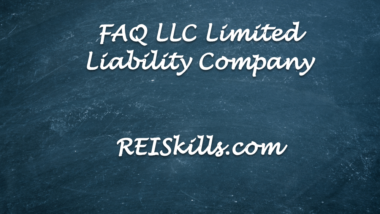FAQ Buying on Lease Purchase
Audio
Lease option contracts, also known as lease purchase options, combine a lease with an option to purchase a property, offering flexibility for both buyers and sellers [1, 2]. These agreements can be used by investors for acquiring or selling properties [3].
Buying Property Using Lease Options
- Advantages: Lease options enable investors to control property with a lower initial cost than purchasing it outright [4, 5]. They also provide the flexibility to decide whether to purchase the property later [4, 5].
- Not being the title holder: A buyer using a lease purchase is not liable for the mortgage, accidents on the property, natural disasters, economic downturns, changes in government regulations, or personal crises [6-8]. They are also not subject to deficiency judgments or bankruptcies [9, 10].
- Option Holder Advantages: Option holders have the lowest cost to control property, the highest leverage profit opportunity, and the ability to choose not to buy at a minimal expense [5]. They also have potential tax benefits [5].
- Depreciation: A lessee may be able to claim depreciation if they have a compelling reason to exercise the option due to a down payment, monthly investment, repairs, management, and other expenditures over the option period [11, 12]. The IRS will consider who has the most “incidents of ownership” to determine who can claim depreciation [13, 14].
- Taxation of Option Money: Option money received by a seller is not reportable until the option is exercised or abandoned [15]. If the option is exercised, the money is considered part of the down payment. If the option is abandoned, it is considered ordinary income [15].
Key Components of a Lease Purchase Agreement
- Option Money: The option money is a nonrefundable payment made by the buyer to the seller for the right to purchase the property at a later date [19]. This money is not taxable to the seller until the option is exercised or abandoned [15, 19].
- Lease Terms: The lease agreement outlines the terms of the tenancy, including the monthly rent, maintenance responsibilities, and other obligations [1, 2].
- Purchase Price: The purchase price is typically agreed upon at the beginning of the lease option and is fixed for the option period [1, 2, 20].
- Monthly Credits: Lease purchase agreements often include a portion of the monthly payment that is credited towards the eventual purchase price [21].
- Length of Option: The length of the option period can vary, but it is typically at least three years [22].
Negotiating a Lease Purchase
- Down Payment:A down payment of at least 10% is typically required [21, 23].
- Monthly Credits:A credit towards the purchase price should be negotiated, often between 10-20% of the monthly payment [21].
- Maintenance Allowance:A maintenance allowance can be negotiated to cover repairs and replacements [22].
- Length of Option and Extensions:A minimum of 3 years, and preferably 5 years, is recommended for the option term [22]. It is also recommended that you negotiate for extensions to the lease purchase contract [24].
- Carryout Financing: The terms should include a 5-10 year term, with interest rates slightly below market [24].
- Monthly Payments: The monthly payment should be similar to or higher than the lease payments [25].
Virtual Options and Contracts
- Virtual options are not a trick or scheme to defraud anyone, but are exactly as written in the document [1].
- A lease and contract for option is a lease, with a separate contract to deliver an option at a later date [2].
- A contract for beneficial interest (CBI) is an agreement for deed, but instead of a contract for a deed on the property, it is a contract for the beneficial interest in a land trust [26].
Legal Considerations
- Legal Issues: There are various legal issues related to option contracts [27, 28]. The sources include a chapter covering legal issues and court cases to help you and your attorney answer legal questions that may arise [28].
- Enforceability: An option is binding only on the seller, not the buyer [29].
- State Laws: Some states have enacted laws impacting lease options, often as a reaction to predatory investor practices [30-34]. These may limit some legitimate investors but the laws can be complied with while still using option strategies [30].
Closing a Lease Purchase
- Escrow: Final documents should be prepared, signed, and placed in escrow with an attorney or title company [35, 36]. This ensures that the contract can be completed without further negotiation [35].
- Documents: The documents that will need to be prepared include an Escrow Agreement, Warranty Deed to buyer, Promissory Note to Buyer, Mortgage to Buyer, Memorandum of Interest, Promissory Note to Seller, Mortgage to Seller, Quit Claim Deed, and Satisfaction of Mortgage [37].
Exercising the Option
- Notification: When the time comes to exercise the option, the buyer informs the seller and escrow agent and sets a date to pay the balance due under the agreement [38].
- Recording: The deed, mortgage, and note are recorded by the escrow agent [38].
- Sandwich Position: When buying on a lease purchase and selling on a lease option, the investor is in a sandwich position [39]. When the tenant/optionee closes early, the investor is paid the difference between the lease purchase price and the tenant’s option price [40, 41].
Lease purchase options can be a complex but useful tool for real estate investors and individuals looking to buy or sell property. They can provide flexibility and potential benefits, but also carry risks and require careful consideration and negotiation [3, 4, 39].



